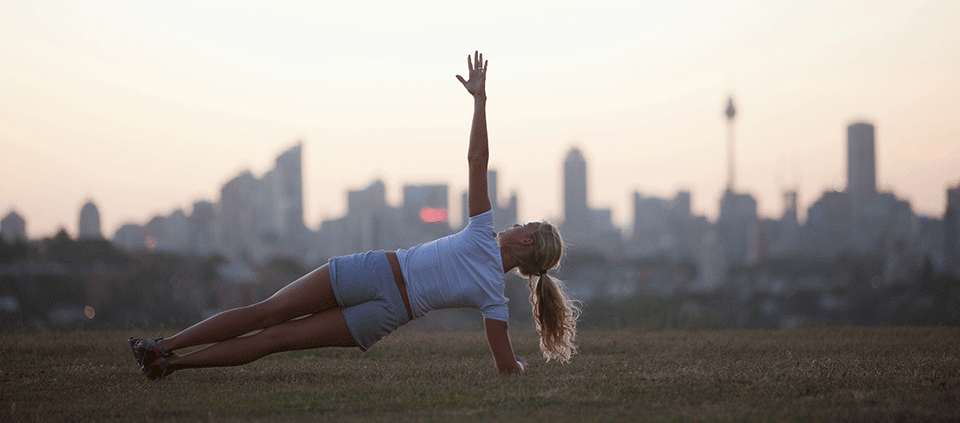What Happened When the Stereo Broke: Practicing Silent Yoga in a Noisy World

by Janet Arnold-Grych
And now the teaching on yoga begins.
Yoga is the settling of the mind into silence.
—Yoga Sutras of Patanjali
When I practice yoga to music, it helps create a fluidity of movement that, like a wave, carries away my to-do lists, rankling conversations, even fatigue or dismay. As a yoga teacher, I can get lost in building playlists that provide that uplifting, peaceful, or contemplative backdrop for my students. I’ve relied on music for years to take them out of their heads, help them move more freely, and lift the overall experience.
That’s why, when the tried-and-true stereo in the yoga studio where I teach refused to play my iPhone last week, I was anxious at first—and then covertly agitated. Neither repeated combinations of buttons and dials nor my silent screams of Please, please, please moved it to produce any sound. There was nothing to do but pivot.
I strode back to the front of the room, clapped my hands together, and told the class that we would have the joy of moving only to the sounds of our breath today. The quiet groans offered by some of the students confirmed that they weren’t particularly thrilled with the situation, either.
It’s not surprising that we groan when faced with the prospect of being left in silence with our thoughts. Their sharp elbows and constant shouts for attention can be exhausting. Without music to restrain them, those thoughts—whether they’re focused on what to make for dinner, the irritating meeting you had at work earlier, or the intimidating balancing poses yet to come—can shake us from our center. That is where the power of the breath comes in. It can help us establish a settled state that blocks out the noise inside our heads—and the lack of noise outside.
As I began to lead my music-free class through the first sequence, I felt a heaviness in the air, a sense of self-consciousness. Perhaps because of a desire to override that self-consciousness, the class quickly hooked on to familiar cues to breathe in, to breathe out, to hear the breath, to synch movement to it. In the silence, the communal breath became stronger, even supportive, as though the breath were coming from one source and moving through one being. A softness blanketed us; the harmony of the group’s breath wove a new texture.
I have been in classes without music before, and I recall thinking that they lacked energy or connection. Now, I wonder if perhaps my filter was simply attuned to what was lacking, rather than what was present. As we ended, I wondered what the students had inwardly experienced. While they did not request that we do it again next week, they did comment on the palpable calm that had pervaded the class, and the peacefulness that seemed to linger.
When Michelle Dalbec, Lead Faculty for the Kripalu School of Yoga, did her teacher training in 2003, the group did the same posture sequence every day, without music. “That was the first time I had been introduced to not using music,” she says. “It’s actually very freeing; it can allow you to be more aware of what's going on in your body and mind. I am very musically oriented”—she’s also a Kripalu YogaDance® teacher—“but I've noticed more recently that I'm starting to pick music without words, so there’s less distraction. When I'm hearing the conversation out there—the music—I’m not hearing the conversation in here, with my body and mind.”
The absence of external distraction enabled my class to become a moving meditation. We flowed with a bit more presence and mindfulness, and those qualities seemed to have a stronger resonance. Patanjali reminds us that, at its core, yoga has nothing to do with how high our leg is in Balancing Half Moon, or if we achieve Handstand or not. It has everything to do with our ability to quiet the mind, so we can see situations off the mat more clearly, and choose our actions with greater wisdom and alignment. When we can be at peace with the flow of our thoughts and sensations on the mat, we can more readily find this ease while doing the dishes, walking the dog, or even in the midst of a difficult interaction.
Says Michelle, “At the end of class, I often encourage students to focus on the difference between when they first came in and how they feel now—and to think about whether there was a factor in creating that stillness. Often it’s attention, intention, or the breath. The great thing about those tools is that we always have access to them—they’re portable, and we can take them with us off the mat."
Once you know the way
the nature of attention will call you
to return, again and again,
and be saturated with knowing,
“I belong here, I am at home here."
—Radiance Sutras (26), as translated by Lorin Roche
Ever-present in our heartbeat, rhythm is indigenous to who we are and how we move. Flowing to music can be joyous and life affirming. And moving to only the music of our breath can be an intimate and powerful experience, too. As a yoga student and teacher, I plan to play with integrating more silence into my practice—and into my daily life in our often noisy world.
Janet Arnold-Grych is a yoga teacher and writer whose work has been published in Elephant Journal, Huffington Post, Third Coast Digest, and other outlets.